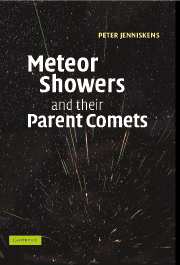Book contents
- Frontmatter
- Dedication
- Contents
- Preface
- Acknowledgements
- Part I Introduction
- Part II Parent bodies
- Part III Young streams from water vapor drag
- 11 Forecasting meteor storms from what planets do to dust trails
- 12 Meteor storm chasing
- 13 Meteor outbursts from long-period comets
- 14 Trapped: the Leonid Filament
- 15 The Leonid storms
- 16 The Ursids
- 17 The Perseids
- 18 Other Halley-type comets
- 19 Dust trails of Jupiter-family comets
- Part IV Young streams from comet fragmentation
- Part V Old streams and sporadic meteoroids
- Part VI Impact and relevance of meteor showers
- Appendix
- Tables
- Index
- Units and constants
13 - Meteor outbursts from long-period comets
from Part III - Young streams from water vapor drag
Published online by Cambridge University Press: 05 July 2015
- Frontmatter
- Dedication
- Contents
- Preface
- Acknowledgements
- Part I Introduction
- Part II Parent bodies
- Part III Young streams from water vapor drag
- 11 Forecasting meteor storms from what planets do to dust trails
- 12 Meteor storm chasing
- 13 Meteor outbursts from long-period comets
- 14 Trapped: the Leonid Filament
- 15 The Leonid storms
- 16 The Ursids
- 17 The Perseids
- 18 Other Halley-type comets
- 19 Dust trails of Jupiter-family comets
- Part IV Young streams from comet fragmentation
- Part V Old streams and sporadic meteoroids
- Part VI Impact and relevance of meteor showers
- Appendix
- Tables
- Index
- Units and constants
Summary
I started chasing meteor storms in earnest when I realized that there is a simple method for predicting when a dust trail is in Earth's path: just wait until the planets Jupiter and Saturn are back at the same location in their orbit. In 1994, I was in hot pursuit of a mysterious class of showers that occurred with no comet in sight. Persistent anecdotal accounts reminded me of ancient days when “stars fell like rain” (Table 1). What follows is a personal account of an exciting storm chase that resulted in the first proof that these showers are due to long-period comets and, for that matter, that some long-period comets have dust trails.
13.1 Far-comet type outbursts
When I first looked into this, there was only one known cause of such outbursts: comet C/1861 G1 (Thatcher), parent of the April Lyrid shower (Fig. 13.1). It was not a very good example, because the orbital period of ∼415 yr is only a factor of two higher than the Halley-type limit of ∼250 yr. As recently as 2001, Vladislav Emel'Ianenko, pointed out that the Lyrid meteoroids may get trapped in the 1:10, 1:11, and 1:12 mean-motion resonances with Jupiter, with orbital periods of 113–150 yr. In his scenario, the Lyrid outbursts could be caused by a cloud of dust trapped in a shorter 60 yr orbit.
The annual Lyrid shower, peaking in the days around April 21/22, has always been my favorite. After the low rates in the cold months of February and March, this shower is the proverbial swallow of spring for observers in the northern hemisphere. The meteors radiate with a medium speed from a direction at R.A. = 272° and Decl. =+33°, in the constellation of Lyra. They appear to be relatively old, the meteoroids are not very fragile and the magnitude distribution is relatively steep at χ = 2.36 ±0.11.
- Type
- Chapter
- Information
- Meteor Showers and their Parent Comets , pp. 172 - 200Publisher: Cambridge University PressPrint publication year: 2006



